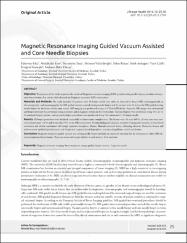| dc.contributor.author | Kılıç, Fahrettin | |
| dc.contributor.author | Eren, Abdulkadir | |
| dc.contributor.author | Tunç, Necmettin | |
| dc.contributor.author | Velidedeoğlu, Mehmet | |
| dc.contributor.author | Bakan, Selim | |
| dc.contributor.author | Aydoğan, Fatih | |
| dc.contributor.author | Çelik, Varol | |
| dc.contributor.author | Gazioğlu, Ertuğrul | |
| dc.contributor.author | Yılmaz, Mehmet Halit | |
| dc.date.accessioned | 08.07.201910:49:13 | |
| dc.date.accessioned | 2019-07-08T20:19:06Z | |
| dc.date.available | 08.07.201910:49:13 | |
| dc.date.available | 2019-07-08T20:19:06Z | |
| dc.date.issued | 2016 | en_US |
| dc.identifier.citation | Kılıç, F., Eren, A., Tunç, N., Velidedeoğlu, M., Bakan, S., Aydoğan, F. ... Yılmaz, M. H. (2016). Magnetic resonance imaging guided vacuum assisted and core needle biopsies. The Journal of Breast Health, 12(1), 25-30. https://dx.doi.org/10.5152/tjbh.2015.2769 | en_US |
| dc.identifier.issn | 2149-1976 | |
| dc.identifier.uri | https://hdl.handle.net/20.500.12511/609 | |
| dc.identifier.uri | https://dx.doi.org/10.5152/tjbh.2015.2769 | |
| dc.description.abstract | Objective: The purpose of this study to present the results of Magnetic resonance imaging (MRI) guided cutting needle biopsy procedures of suspicious breast lesions that can be solely detected on Magnetic resonance (MR) examination. Materials and Methods: The study included 48 patients with 48 lesions which were solely be observed in breast MRI, indistinguishable in ultrasonography and mammography, for MR guided vacuum-assisted cutting needle biopsy and 42 patients with 42 lesions for MR guided cutting needle biopsy for the lesions of the same nature. MR imaging was performed using a 1.5-Tesla MRI device. Acquired MR images were determined and biopsy protocol was performed using computer-aided diagnosis system on the workstation. Vacuum biopsies were performed using 10 G or 12 G automatic biopsy systems, cutting needle biopsy procedures were performed using fully automated 12 G biopsy needle. Results: All biopsy procedures were finalized successfully without major complications. The lesions were 54 mass (60%), 28 were non-mass contrast enhancement (31%) and 8 were foci (9%) in the MR examination. Histopathological evaluation revealed 18 malignant (invasive, in-situ ductal carcinoma and lobular carcinoma), 66 benign (apocrine metaplasia, fibrosis, fibroadenomatoid lesion, sclerosing adenosis, fibrocystic disease and mild-to-severe epithelial proliferation) and 6 high-risk (atypical ductal hyperplasia, intraductal papilloma, radial scar) lesions. Conclusion: Magnetic resonance guided vacuum and cutting needle biopsy methods are successful methods fort he evaluation of solely MRI detected suspicious breast lesions. There are several advantages relative to each other in both methods. | en_US |
| dc.language.iso | eng | en_US |
| dc.rights | info:eu-repo/semantics/openAccess | en_US |
| dc.subject | Magnetic Resonance Imaging | en_US |
| dc.subject | Breast Neoplasm | en_US |
| dc.subject | Image-Guided Biopsy | en_US |
| dc.subject | Vacuum | en_US |
| dc.subject | Large Core Needle | en_US |
| dc.title | Magnetic resonance imaging guided vacuum assisted and core needle biopsies | en_US |
| dc.type | article | en_US |
| dc.relation.ispartof | The Journal of Breast Health | en_US |
| dc.department | İstanbul Medipol Üniversitesi, Tıp Fakültesi, Dahili Tıp Bilimleri Bölümü, Radyoloji Ana Bilim Dalı | en_US |
| dc.authorid | 0000-0003-0958-6581 | en_US |
| dc.identifier.volume | 12 | en_US |
| dc.identifier.issue | 1 | en_US |
| dc.identifier.startpage | 25 | en_US |
| dc.identifier.endpage | 30 | en_US |
| dc.relation.publicationcategory | Makale - Uluslararası Hakemli Dergi - Kurum Öğretim Elemanı | en_US |


















